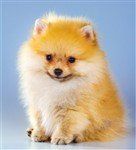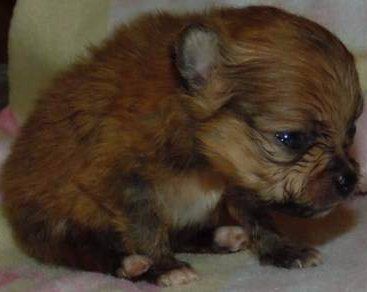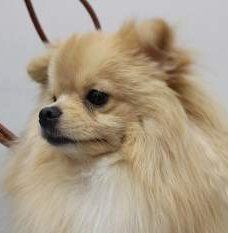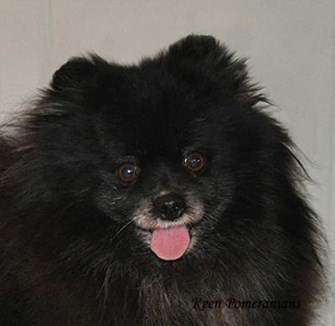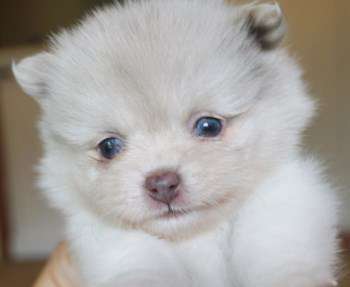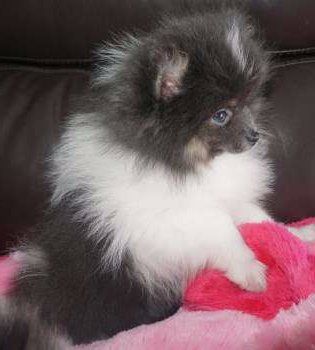Pomeranian Eye Color
Overview

Cody, 2 years old
Photo courtesy of Pat Riccardi
- The AKC, FCI, CKC and KC eye color standards
- All of the possible eye colors found with Pomeranians
- Why newborn puppies have blue eyes
- Photos and explanations of different eye colors
- Eye color changes
Breed Standard Eye Descriptions
If the standard coloring for Pomeranian's eyes could be summed up in one word, it would be 'dark'.
Let's first look at what each major canine kennel clubs states in their standards:
AKC:
Dark, bright, medium sized and almond shaped
CKC
(Canadian Kennel Club): The eyes should be medium in size, rather than oblique in shape, not set too wide apart, or too close together, bright and dark in colour. The eye rims of the blues and browns are self-coloured.
FCI:
The eyes are of medium size, longish shape, slightly slanting and dark.
KC
(The Kennel Club of the United Kingdom): Medium size, slightly oval, not full, or set too wide apart; bright, dark and showing great intelligence. In white, orange, shaded sable and cream dogs, rims black.
So as you can see, each one uses the term 'dark' to described expected eye coloring. What does this mean? The eyes 'should' be in the brown family with a preference toward deep, rich dark brown. Along with the shiny element (seen in normally healthy dogs), it can be described as a vibrant sparkling, dark milk chocolate.
Depending on the lighting and angle when looking at a Pom, they can border on black (making it difficult to see the pupil) or sparkling with rich deep amber accents if the light catches them a certain way.
Possible Eye Colors
Despite the above, all of the following eye colors can be found in Pomeranians, some more often than others:
• Light blue
- Rare but does exist. Most commonly seen with Merles.
• Dark blue
- Newborns are born with dark blue eyes. For the majority, they will change to brown between the young age of 4 to 6 weeks; though with some it will be a bit sooner & some a bit later.
Therefore, in most cases this happens well before the puppy arrives at his new home. A very few select Poms will retain their blue eyes and for those that do, the color will often lighten.
Blue Poms (solid or parti), which are those that have blue skin pigmentation, may keep their dark navy eyes.
• Hazel
- These are a mixture of brown and green. If a dog has hazel eyes, many refer to that Pom as having green eyes; though solid green would be exceedingly rare for this breed.
• Amber
- A light brown, golden hue
• Medium brown
- The 2nd most common eye color for this breed.
• Dark brown
- The #1 most common Pomeranian eye color.
• Odd eyed
- This is when each eye is a different color. Some refer to this as 'parti' eyes, however this term should only be applied to the Pomeranian's coat (two colors). The technical term for this is Heterochromia.New Paragraph
AKC Accepted Eye Colors
The AKC calls for dark eyes, and dark eyes = dark brown. This is the most common eye color for the Pomeranian breed, but not the only one that is allowed.
Though the breed standard clearly defines eyes to be dark, the AKC does accept self-coloring eyes with Pomeranians. What does this mean? For certain coat colors, the eyes may 'match' the skin. And this rule applies to coats that are diluted. The 2 official diluted coats that are allowed to have self-coloring eyes are:
• Chocolate
• Blue
*
Lavender is an exotic diluted color that does exist, yet is not an accepted coat color (more ahead).
The dilution gene that creates Chocolates
and Blues can (and often does) also fall to the eyes, and for that reason, self-coloring eyes must be allowed.
The reason why it must be allowed is because if the coat color exists and is accepted as an official color and the dilution gene that creates that coat often affects the eye color, to not accept the eye color would be equivalent to not accepting the overall color of the Pomeranian.
Here is how this works:
• Chocolate coat: Expected eye color is hazel (light brown and green mixture, sometimes with gold rings or flecks) or light brown.
• Blue: Blue eyes are allowed. These will normally be rather dark, often described as a navy.
Dark blue navy eyes on a 3 week old Orange Sable Pomeranian puppy. Photo courtesy of Paquin Poms
Eye Color of Newborn Pomeranian Puppies
Similar to humans, dogs are also born with blue eyes, however for most Pomeranians this will be a very short window of time.
Puppies are born with the eyelids closed; they can technically see and are not blind, however the lids are sealed tightly and will open around the age of 2 weeks old.
It should be noted that if the lids open accidentally (are wiped open via handling, etc.) they should be gently swept back down with the palm of the hand or soft wash cloth and lights in the room should be kept very dim.
When they open on their own at the 2 week mark, they will be a beautiful dark blue color.
The reason why Pom puppies have blue eyes (and other dogs and humans as well) at birth is due to a low level of melanin in the eyes. Melanin gives the eyes color; the more there is, the darker the eyes.
When a puppy is born, he/she does not have the level of melanin that he/she is going to have when mature. As the pup grows, the melanin slowly increases, which causes the eyes to darken to brown.
Many Pom puppies
will change over from dark blue to brown eyes before they reach their new homes at the age of 8 weeks old.
However, there can still be changes up until approximately 4 months old; and less commonly, slight changes for years. If a Pomeranian is to have the rare but possible light blue eyes (seen in merles but not accepted by the AKC) or hazel, typically the 'puppy blue' that you see at the newborn stage will be a bit clearer and not such a dark, navy blue.
Eye Color Examples and Explanations
Dark Brown Eyes-
This is the color that 'dark' refers to in the breed standard and is the most commonly seen color with Pomeranians. The eyes are dark, almond shaped (round with a slight angling from the middle of the upper lid down to the corners which makes them quite characteristic) and shiny… quite beautiful!
Depending on the lighting and even the base coat color, they may appear to be so dark that they are black (making it difficult to see the pupil) or may be a bit lighter, allowing you to see the shiny brown hue.
Another factor that comes into play is the eye rims. When the rims are black, the eyes will often appear darker and also larger. The majority of the time, the eye rim color will match the paws, nose and lips.
This color is so common for 2 reasons: 1)
Brown is dominant over other colors.
If you paired a brown eyed Pom with a hazel eyed Pom, the resulting litter would be more prone to have brown eyes, unless the brown eyed Pom had dilution genes in his/her bloodline and those were passed down.
2)
Only coat colors that are diluted (Chocolate, Blue [both accepted], Lavender [not an official color but does exist]) and Merles [the merle gene affects the eye color but the AKC does not accept blue eyes in Merles, more ahead] have eye color other than brown…
Medium Brown/ Light Brown
- These shades of brown will have slightly less melanin than super dark eyes.
The element that sets apart dark brown from medium brown will be the color difference between the iris and the black pupil. When you can very clearly see the dog's pupil, this will let you know that the eyes are medium or light brown.
It's interesting to note that it is not actually the pupil that changes size. The iris (the colored part) is what controls how much light enters the pupil. When the smooth muscles of the iris contract, this makes the pupil appear smaller.
Pomeranians with medium to light brown eyes will have this feature show more when the pupils are small… this will happen if the dog is looking at something that is far off in the distance or when turned away from a light source, for example when the dog has his back to the window as opposed to looking out of it.
Blue Eyes-
Blue eyes are very rare with the Pomeranian breed, however this does exist and it is only sometimes accepted by the AKC. It should be noted that these rules may change and in the past, there have been changes regarding which eye colors will be accepted and which will not.
It is accepted only if it is the result of self-coloring in solid or parti Poms that hold a diluted color… Most Chocolates and Blues will have dark blue or hazel eyes due to the dilution genes that affects both coat and eye color.
This Pom that you see (to the right -computer/tablet -or below- mobile) is a Lavender Pom, which is not an official color.
However, this Pom is certainly AKC registerable and would need to be registered as a color that best matches. While there is debate regarding what, exactly, produces Lavenders, the most widely held belief is that it is a diluted Blue (though Beaver may play a role) and for that reason, many are registered as Blue.
This may, at first, appear to be a white sable; however this is a gorgeous Lavender Pomeranian with clear, shiny, light blue eyes. Photo courtesy of Pomarazzi Pomeranians (one of our recommended breeders)
Since the coat is obviously diluted, any diluted eye color is also accepted and that means that these blue eyes are not only beautiful, they are expected.
A Tri blue parti with dark blue eyes. Blue eyes are allowed due to 'self coloring' eyes. The blue in the coat (a diluted color) can and often does affect the eyes. Photo courtesy of Pomarazzi Pomeranians
There are 4 Elements to Note:
1.
The ability to have blue or hazel eyes also applies to any parti Pom (two or more colors) in which one of those colors is diluted. For example, blue or hazel eyes in a chocolate and tan parti or a blue and white parti, etc.
2.
Blue Poms often appear to be black. However, blue is dependent on skin pigmentation. This is most noticeable on the nose; though it includes nose, paws, eye rims and paws. If the nose is blue (it will be a dark navy) and not black, the dog is blue no matter what the hue of fur.
See also: Pomeranian nose coloring. There are also (much more rare) orange, orange sable or other coat colors that will have blue skin, technically making them blues and therefore able to have blue or hazel eyes.
3.
Blue or hazel eyes can be hereditary but will only be passed down if the dog that has them is paired with another dog that does not cancel it out with dominant brown.
4.
There is no way to guarantee the eye color of a Pomeranian. Mother Nature always has the final say. If you fall in love with a blue eyed Pom puppy and are told that one or both of the parents have blue eyes as well, there is still a chance that the pup's peepers will change to brown as he/she matures.
Knowing the genetics of the dam & sire is certainly helpful and the older the pup is when you see the sparkling blues, the more confident you can feel that it will hold.
Nico, at 6 and 10 months; Photo courtesy of Stacy Roberts
If a Pomeranian has hazel eyes and is cozied up in a blue blanket, his eyes will take on a bluer tint… If the dog had a green piece of clothing
slipped onto him, his eyes would pick up that color and look much more green.
Also, the various colors of gold, blue, and green will show to variable amounts depending on whether the dog is outdoors with natural lighting or is inside with artificial lighting.

Fi Fi, at 11 months, a chocolate Pom with green eyes, Photo courtesy of Amanda
A Blue Merle Extreme Piebald Parti Pomeranian with light blue eyes. Photo courtesy of Pomarazzi Pomeranians.
Eye Colorof Merle Pomeranians
Eye Color of Merle Pomeranians
Blue eyes are not accepted by the AKC even if the Pom is Merle and that's really a shame in some ways because it is just so stunningly beautiful.
Merle
is an accepted coat color and the merle gene is a random dilution gene that causes a 'splattering' effect where color on the dog can land anywhere. It never lands in the same place twice (2 or more
Merle puppies in a litter will never look the same).
This gene can also affect the eyes. If it does, it may affect one eye or both. And if so, it can affect color in a variety of ways, ranging from the eye(s) being completely light blue to having speckles or freckles.
In some cases, it will cause the Pom to be 'odd eyed' which means having two different colored eyes (one blue, one hazel)- more ahead.
The American Pomeranian Club and the AKC are trying to discourage cryptic merles (also referred to as phantom). These are Poms that carry the gene but do not show it in their coats.
And this is thought of as dangerous because you do not want to pair two Merles together when breeding, due to possible health issues that can arise… If cryptic Poms exist, they can be accidentally bred to a 'regular' Merle.
In an effort to minimize the amount of Poms that are cryptic or phantom, they now do not accept blue eyed Merles…. And this is tricky for those that breed for this. The gene can fall anywhere and there is no method of controlling whether or not it lands in one or both eyes.
***
While exceedingly rare, if a dog were to have double dilution of the eyes, this could cause them to be a yellow/gold color (sometimes referred to as Wolf Eyes).
One blue eye, one brown eye
Photo courtesy of Keen Pomeranians
Odd Eyed - Each Eye is a Different Color
As explained above, this only occurs when there are merle genes at play. That gene splatters color and while it will do this to the coat, it can do this to one or both eyes. The technically term for this is Heterochromia.
You may see a Pomeranian with two different colored eyes yet the dog does not appear to have any merle on him. In most cases, this will be due to it being hidden; this means that it is in the bloodline but is not outwardly showing.
While being odd-eyed is considered a major fault, many dog owners like the idea of having a dog that has such a unique feature.
Heterochromia has not been shown to lead to any sort of health issues. With animals that have this feature, vision is normal and there are no increased occurrences of cataracts, etc.
Quick Reader Q&A
Q: Do Pomeranians with blue eyes have an increased risk of eye related health issues? Do they go blind more easily?
A:
In most cases, no. The only time that an issue may arise is if the puppy was the result of breeding merle to merle, making the Pom a 'double merle'. This may lead to vision issues and other eye defects.
Q: Up until what age can a Pomeranian have changes to her eye color?
I'd swear that my 4 year old Pom has much lighter eyes than she used to.
A:
While the most noticeable changes will take place when the Pom is very young (from when eyes open at 2 weeks old up until 4 months old), there can definitely be subtle changes for quite some time.
As the Pom matures, eyes can lighten or darken somewhat… and then just when you think that the color has finally set in stone, when a dog starts to mature from adult to senior, there may be another slow and gradual change (more ahead on senior issues). With the very rare hazel eyes, it is common for there to be changes in intensity all throughout the dog's life.
Q: What is considered normal eye color changes with senior Pomeranians and what would point to a problem?
A:
As dogs age into seniors, it is not uncommon for the eyes to develop a blueish tint or a slight haze, particularly noticeable over the pupil area. You can sometimes see this with Poms that are 10+ years. The medical term for this is lenticular sclerosis or nuclear sclerosis. This is considered to be a normal part of aging for canines and does not affect vision to any notable degree.
However, it is important for this to not be mistaken for a clouding of the eyes due to cataracts, which can affect vision. While this most often affects older dogs, it can be present at birth (congenital) or develop early (juvenile).
With cataracts, there will a change to the eye color in one or both eyes (though usually both); this will be a blue, gray or white tint or haze to them.
It is important to report any clouding, hazing or color changes to the vet so that a determination can be made as to whether it is due to lenticular sclerosis, cataracts or another issue.
Q: If I were to try and breed for green eyed Pomeranians or blue eyed Poms (a possible goal in the very far future), what pairings could produce those eye colors?
A:
Green or hazel eyes are tied to Chocolates and Blues and blue eyes are tied to Blues and Merle, though blue eyed Pomeranians with any Merle are currently frowned upon by the AKC.
You would need to limit the sires and dams to those colors. For example, if you brought a black Pom
into the program, that would erase the potential green eyes.
Are You Part of the PetPom Family?
Become a Free PetPom Member so that you can stay up-to-date on new information that's added to the site & know about special happenings. You will also receive a fun & helpful Welcome Booklet.
Popular Pages:
Supplies You Need for a Pomeranian
- A list of what is needed to take optimal care of your Pom.
Pomeranian Allergies
- Fixing this once and for all; it's time for your Pom to start feeling better.
Helping a Pomeranian When He's Home Alone
- Helpful advice for Poms that struggle with separation anxiety, and how to set up the perfect spots for a Pom when he's by himself.
Stopping a Pomeranian From Barking
- How to curb excessive vocalization.

